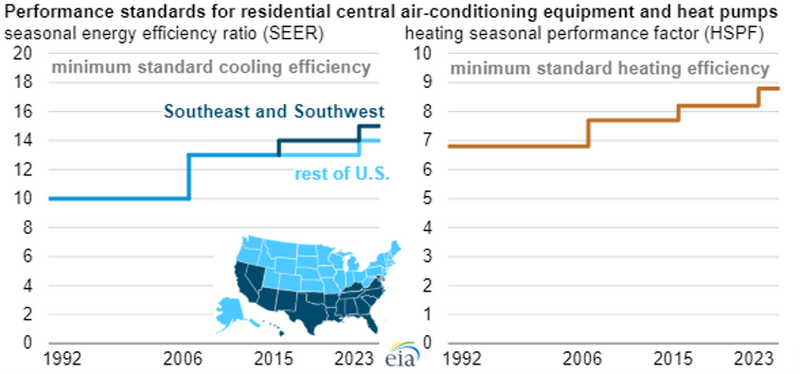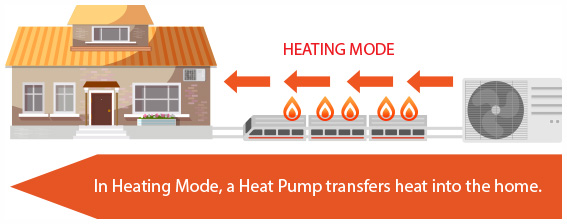
Decoding HSPF: What It Means and Why It Matters for Homeowners
As homeowners, it matters to know what HSPF is and how it can impact the efficiency and effectiveness of your heating system. Decoding HSPF, or Heating Seasonal Performance Factor, is key to making informed decisions about your home’s heating needs.
HSPF is a measure of how well a heat pump or heating system performs during the heating season. It takes into account both the heating output (in BTUs) and the electricity used to generate that heat. A higher HSPF rating signifies a more energy-efficient system, which can result in lower energy bills and a reduced carbon footprint.
Understanding HSPF is important because it can help homeowners determine the efficiency and cost-effectiveness of different heating systems. By comparing the HSPF ratings of different models, homeowners can make informed decisions about which system best meets their needs in terms of both comfort and energy savings.
What is HSPF?
HSPF stands for Heating Seasonal Performance Factor, and it is a term that homeowners may encounter when researching heating systems for their homes. Decoding the acronym HSPF is important because it directly affects a homeowner’s comfort, energy efficiency, and overall savings.
The HSPF is a measure of a heat pump’s efficiency and its ability to provide warmth efficiently throughout the heating season. It is similar to the SEER (Seasonal Energy Efficiency Ratio) rating for air conditioners and is an important consideration when choosing a heat pump for residential use.
The HSPF is calculated by dividing the total heating output of a heat pump during the heating season by the total electrical energy consumed. The higher the HSPF rating, the more efficient the heat pump is, and the less energy it will consume while providing heat. This means that a higher HSPF rating can result in lower energy bills for homeowners.
Understanding the HSPF rating is crucial for homeowners because it helps them make informed decisions when choosing a heating system. In colder climates, where heating needs are more significant, a higher HSPF rating can result in greater energy savings over time. Additionally, some utility companies may offer incentives or rebates for the installation of heat pumps with higher HSPF ratings, further increasing potential savings.
In summary, the HSPF is a measure of a heat pump’s efficiency and its ability to provide warmth efficiently. Homeowners should pay attention to the HSPF rating when selecting a heating system as it can impact their comfort, energy efficiency, and savings. Decoding HSPF matters and can lead to making more informed decisions about home heating systems.
| Heating Seasonal Performance Factor (HSPF) | The measure of a heat pump’s efficiency and its ability to provide warmth efficiently throughout the heating season. |
| SEER (Seasonal Energy Efficiency Ratio) | The measure of an air conditioner’s efficiency. |
Understanding the Heating Seasonal Performance Factor
The Heating Seasonal Performance Factor (HSPF) is a term that homeowners should become familiar with when it comes to understanding the efficiency of their heating systems. Knowing what HSPF means and why it matters can help homeowners make informed decisions when it comes to purchasing and maintaining their heating systems.
HSPF is a measure of the efficiency of a heat pump or heating system over an entire heating season. It takes into account the heating capacity of the system and the amount of electrical energy it consumes. The higher the HSPF rating, the more efficient the system is at converting electrical energy into heat for the home.
Decoding the HSPF rating can give homeowners a clearer understanding of how efficiently their heating system operates. A higher HSPF rating indicates that the system can provide more heat output per unit of electrical energy input. This means that homeowners can potentially save on their energy bills by investing in a heating system with a higher HSPF rating.
Understanding the HSPF is important for homeowners because it can help them make informed decisions when it comes to selecting a new heating system. By choosing a system with a higher HSPF rating, homeowners can ensure that they are investing in an energy-efficient system that will help them save on their energy bills in the long run.
In addition to selecting a heating system with a high HSPF rating, homeowners should also prioritize regular maintenance and proper usage of their systems. Keeping the system clean, changing filters regularly, and scheduling professional inspections can help maximize the efficiency and longevity of the system.
In conclusion, decoding the Heating Seasonal Performance Factor is important for homeowners because it helps them understand the efficiency of their heating systems. By selecting a system with a high HSPF rating and maintaining it properly, homeowners can ensure that their heating system operates efficiently and helps them save on their energy bills.
Why do Homeowners Need to Know About HSPF?
Understanding and knowing about the HSPF (Heating Seasonal Performance Factor) is essential for homeowners because it directly affects their comfort, energy efficiency, and monthly utility bills. HSPF is a measure of how efficiently a heat pump operates during the heating season. The higher the HSPF rating, the more energy-efficient the heat pump is, which ultimately means lower energy costs for homeowners.
Decoding the HSPF rating is crucial for homeowners as it helps them make informed decisions when purchasing or upgrading their heating systems. By knowing the HSPF of different heat pumps, homeowners can compare the energy efficiency and performance of various models and choose the one that best suits their needs and budget.
HSPF also matters because it affects the overall environmental impact of a home’s heating system. Higher HSPF ratings translate to lower greenhouse gas emissions, reducing the carbon footprint of a household. By opting for a heat pump with a high HSPF rating, homeowners can contribute to a greener and more sustainable future.
Additionally, understanding HSPF allows homeowners to evaluate the operating costs of their heating systems. By knowing the HSPF of their current heat pump, homeowners can estimate their annual energy consumption and calculate potential savings with a more energy-efficient model. This knowledge empowers homeowners to make financially sound decisions, maximizing energy savings and minimizing expenses.
In conclusion, decoding HSPF and understanding its implications is vital for homeowners. It empowers them to make informed decisions, improve energy efficiency, lower utility bills, and contribute to a greener future. By staying informed and knowledgeable about HSPF, homeowners can ensure the comfort, cost-efficiency, and sustainability of their homes.
Energy Efficiency and Cost Savings
When it comes to homeowners and their HVAC systems, understanding the energy efficiency and cost savings associated with the HSPF rating is crucial. Decoding the HSPF rating and understanding what it means for your system can greatly impact your monthly energy bills and overall comfort.
HSPF, or Heating Seasonal Performance Factor, is a measure of a heat pump’s efficiency over an entire heating season. A higher HSPF rating means better energy efficiency and cost savings for homeowners. By investing in a heat pump with a higher HSPF rating, homeowners can expect to see significant reductions in their heating and cooling costs.
One of the key benefits of a high HSPF rating is its ability to save homeowners money. By choosing a heat pump with a higher HSPF rating, homeowners can significantly reduce their energy consumption and lower their monthly utility bills. In addition to cost savings, a high HSPF rating also means a more environmentally friendly home, as less energy is being used and wasted.
Another important aspect of HSPF is its impact on comfort. Higher HSPF ratings mean that the heat pump is more efficient at maintaining a consistent temperature throughout the home. This results in a more comfortable living environment, with fewer hot or cold spots in different areas of the house. By investing in a heat pump with a high HSPF rating, homeowners can ensure that their home remains comfortable and enjoyable all year round.
Overall, understanding the HSPF rating and its impact on energy efficiency and cost savings is essential for homeowners. By decoding the HSPF rating and making informed decisions when it comes to their HVAC system, homeowners can enjoy significant cost savings, increased comfort, and a more environmentally friendly home.
| Significant cost savings |
| Reduced energy consumption |
| Lower monthly utility bills |
| Increased comfort |
| More environmentally friendly |
Choosing the Right Heating System
When it comes to keeping your home comfortable and cozy, the type of heating system you choose matters. One important factor to consider is the HSPF (Heating Seasonal Performance Factor) rating of the system.
But what exactly does HSPF mean?
HSPF is a measure of a heating system’s efficiency, specifically for heat pumps. It represents the total heating output of the system during the heating season, divided by the total electrical energy input. In simpler terms, it tells you how effectively the system converts electrical energy into heat.
For homeowners, understanding the HSPF rating is essential when deciding on a heating system. A higher HSPF rating means better efficiency, which translates to lower energy consumption and lower heating costs.
So, how can you choose the right heating system based on HSPF?
- Look for systems with higher HSPF ratings. A higher rating indicates better energy efficiency and cost savings in the long run.
- Consider your climate. If you live in an area with mild winters, a heat pump with a lower HSPF rating may be sufficient. However, in colder climates, it’s advisable to invest in a system with a higher HSPF to ensure adequate heating.
- Consult with a professional HVAC contractor. They can assess your home’s specific heating needs and recommend the most suitable system based on factors such as your home’s size, insulation, and existing ductwork.
- Take into account your budget and long-term savings. While systems with higher HSPF ratings might have a higher upfront cost, they can lead to significant energy savings over time, making them a worthwhile investment.
Choosing the right heating system for your home is crucial for both comfort and cost-effectiveness. By considering the HSPF rating, climate, professional advice, and budget, you can make an informed decision that will keep your home warm and cozy while minimizing your energy expenses.
How HSPF is Calculated
The HSPF, or Heating Seasonal Performance Factor, is a measurement used to determine the efficiency of a heat pump. It represents the ratio of heat output to electricity consumption over the course of a typical heating season.
To calculate the HSPF, the total heat output of the heat pump is divided by the total electricity consumption, including both the heat pump and any auxiliary systems. This provides a numerical value that represents the efficiency of the system.
For homeowners, understanding the HSPF is important because it indicates how efficiently a heat pump can convert electricity into heat. The higher the HSPF rating, the more efficient the heat pump is and the more cost-effective it will be to operate.
The HSPF matters because it can help homeowners make informed decisions when choosing a heat pump for their home. By comparing the HSPF ratings of different models, homeowners can determine which one offers the best energy efficiency and long-term savings. Additionally, federal regulations require a minimum HSPF rating for heat pumps, so understanding the HSPF can ensure compliance with these standards.
Factors Considered in HSPF Rating
When it comes to decoding HSPF, understanding the factors considered in the HSPF rating is essential for homeowners. The HSPF rating stands for Heating Seasonal Performance Factor, which is a measure of the heating efficiency of a heat pump.
- Energy Efficiency: The HSPF rating takes into account the energy efficiency of the heat pump. Higher HSPF ratings indicate greater energy efficiency, which can result in lower energy costs for homeowners.
- Cycle Length: The cycle length of the heat pump’s operation is also considered in the HSPF rating. A longer cycle length indicates that the heat pump can maintain a consistent temperature for a longer period of time, resulting in improved energy efficiency.
- Auxiliary Heat: The use of auxiliary heat, such as electric heating strips, is another factor considered in the HSPF rating. Heat pumps that rely less on auxiliary heat are generally more efficient and have higher HSPF ratings.
- Climatic Conditions: The HSPF rating is also influenced by the climatic conditions in which the heat pump operates. The rating takes into account both cold and mild climate conditions to determine the overall efficiency of the heat pump.
- Defrosting Capability: The ability of the heat pump to defrost itself when ice builds up on the outdoor unit is an important factor in the HSPF rating. Heat pumps with effective defrosting capabilities can maintain their efficiency even in cold weather conditions.
Understanding these factors can help homeowners make informed decisions when it comes to choosing a heat pump for their home. By considering the HSPF rating and the factors that influence it, homeowners can select a heat pump that provides optimal energy efficiency and comfort for their specific needs.
Interpreting HSPF Ratings
Decoding HSPF ratings is crucial for homeowners to understand the efficiency and performance of their heating systems. HSPF stands for Heating Seasonal Performance Factor, which is a measure of the heating efficiency of a heat pump. But what does this rating actually mean for homeowners?
In simple terms, the HSPF rating measures the ratio of heat output to energy input over the course of a heating season. A higher HSPF rating means that the heat pump is more efficient in converting energy into usable heat.
For homeowners, the HSPF rating matters because it directly impacts the energy consumption and costs of heating their homes. A higher HSPF rating means lower energy consumption and potentially lower utility bills. On the other hand, a lower HSPF rating may result in higher energy consumption and higher utility bills.
In addition to energy efficiency, the HSPF rating also gives homeowners an idea of the heating capacity of a heat pump. A higher HSPF rating usually indicates a higher heating capacity, meaning the heat pump can provide more heat to effectively warm up a home.
To help homeowners make informed decisions, manufacturers provide HSPF ratings for their heat pumps. These ratings are determined through standardized testing procedures and provide a useful benchmark for comparing different models. Homeowners can consult the HSPF rating when choosing a heat pump for their homes, ensuring they select a system that meets their heating needs while maximizing energy efficiency.
In summary, understanding and interpreting HSPF ratings is crucial for homeowners. It determines the efficiency, energy consumption, and heating capacity of heat pumps, directly impacting energy costs and comfort levels in the home. By decoding HSPF ratings, homeowners can make informed decisions and choose the most suitable heat pump for their needs.
The Importance of HSPF in Different Climates
Decoding HSPF and understanding what it means for homeowners is crucial when it comes to optimizing energy efficiency and maintaining a comfortable indoor climate throughout the year. HSPF, or Heating Seasonal Performance Factor, is a rating that measures the heating efficiency of a heat pump system. The higher the HSPF rating, the more efficient the heat pump is.
But why does HSPF matter, especially in different climates? Well, the HSPF rating takes into account factors such as outdoor temperatures, system airflow, and defrost cycles to determine how efficiently a heat pump can provide heat in colder weather. In regions with colder climates, a higher HSPF rating is essential to ensure that the heat pump can effectively heat the home without wasting energy.
On the other hand, in milder climates, a lower HSPF rating may still be sufficient to maintain a comfortable indoor temperature during the heating season. Homeowners in these areas may prioritize other factors, such as initial cost or cooling efficiency, over a high HSPF rating.
However, it is important to note that even in milder climates, an inefficient heat pump system can result in higher energy bills and decreased comfort. By understanding the HSPF rating and its significance, homeowners can make informed decisions when purchasing a heat pump system and ensure that it is suitable for their specific climate.

In summary, the importance of HSPF in different climates cannot be understated. It directly impacts the energy efficiency and effectiveness of a heat pump system in providing heating during colder weather. Homeowners should consider their specific climate conditions when evaluating HSPF ratings to ensure optimal comfort and energy savings.
HSPF and Cold Winters
Decoding what HSPF means for homeowners is particularly important during cold winters. HSPF, or Heating Seasonal Performance Factor, is a measure of a heat pump’s efficiency in heating mode. It takes into account the amount of heat produced by the heat pump and the amount of electricity used to produce that heat.
During cold winters, when the temperature drops significantly, homeowners rely heavily on their heating systems to keep their homes warm and comfortable. Understanding the HSPF rating of a heat pump can help homeowners make informed decisions about their heating system.
A higher HSPF rating indicates a more energy-efficient heat pump, which means that it can produce more heat while consuming less electricity. This can translate to cost savings for homeowners, especially during cold winters when heating systems are used for extended periods of time.
By decoding the HSPF rating and understanding its significance for homeowners, individuals can choose a heat pump that meets their specific heating needs, while also considering energy efficiency and cost savings. This can lead to a more comfortable and economical winter heating experience for homeowners.
HSPF and Mild Winters
Homeowners often wonder what decoding HSPF and understanding its importance means for them, especially those who live in areas with mild winters.
HSPF, which stands for Heating Seasonal Performance Factor, is a measure of the efficiency of a heat pump in heating mode. It takes into account both the energy output and the energy input, providing homeowners with a clear understanding of how efficiently their heat pump can heat their home.
While it is true that homeowners in areas with mild winters may not rely on their heat pump as heavily as those in colder climates, understanding the HSPF rating is still important. A higher HSPF rating indicates a more efficient heat pump, which means lower energy bills and a smaller carbon footprint.
Even during mild winters, there will still be cold days and nights when a reliable heating system is necessary. By choosing a heat pump with a high HSPF rating, homeowners can ensure that their homes stay comfortable while minimizing their energy consumption.
Furthermore, an efficient heat pump with a high HSPF rating can also provide cooling during the summer months, making it a versatile and cost-effective solution for year-round comfort.
Ultimately, decoding HSPF and understanding its importance allows homeowners to make informed decisions when choosing a heat pump. Whether they live in an area with mild winters or harsher climates, investing in a heat pump with a high HSPF rating can lead to long-term energy savings and environmental benefits.
So, no matter the climate, HSPF matters for homeowners.
Comparing HSPF to Other Efficiency Ratings
Now that we’ve decoded what HSPF means and how it is calculated, it’s important to understand how it compares to other efficiency ratings. When it comes to heating systems, there are several different rating systems that can be used to measure efficiency. However, HSPF is specifically designed to measure the efficiency of heat pumps, making it the most relevant rating for homeowners considering this type of system.
One of the most common efficiency ratings that homeowners may come across is the Seasonal Energy Efficiency Ratio (SEER). SEER is typically used to measure the cooling efficiency of an air conditioner or heat pump. While it can provide valuable information about the system’s overall efficiency, it does not take into account the heating performance like HSPF does.
Another rating that homeowners may encounter is the Annual Fuel Utilization Efficiency (AFUE). AFUE is used to measure the efficiency of furnaces and boilers that burn fuel to generate heat. While AFUE is important for homeowners who rely on these types of systems, it does not accurately reflect the performance of heat pumps.
When comparing HSPF to other efficiency ratings, it’s important to remember that each rating is specific to a certain type of heating or cooling system. While SEER and AFUE may be valuable metrics for their respective systems, they do not capture the full picture of a heat pump’s efficiency like HSPF does. As a homeowner, understanding the different efficiency ratings and their relevance to your specific heating and cooling needs can help you make an informed decision when choosing a system for your home.
| HSPF | Heating Seasonal Performance Factor | Heat pumps |
| SEER | Seasonal Energy Efficiency Ratio | Air conditioners, heat pumps |
| AFUE | Annual Fuel Utilization Efficiency | Furnaces, boilers |
Understanding the meaning of HSPF and how it compares to other efficiency ratings can help homeowners make informed decisions about their heating and cooling systems. While each rating serves a specific purpose, HSPF is the most relevant and important rating for homeowners considering heat pumps.
HSPF vs. SEER
When it comes to understanding the efficiency and performance of your HVAC system, two important terms you may encounter are HSPF and SEER. As a homeowner, it is crucial to decode what these acronyms mean and how they impact your comfort and energy usage.
HSPF stands for Heating Seasonal Performance Factor, while SEER stands for Seasonal Energy Efficiency Ratio. HSPF measures the heating efficiency of a heat pump by dividing the total heating output over a heating season by the total electric power input during the same period. SEER, on the other hand, measures the cooling efficiency of an air conditioner or a heat pump by dividing the total cooling output over a cooling season by the total electric power input during the same period.
Both HSPF and SEER are important metrics to consider when evaluating the efficiency of your HVAC system. A higher HSPF or SEER rating indicates a more efficient system. Choosing a system with a higher HSPF or SEER rating can result in lower energy bills and a reduced carbon footprint.
It is important to note that HSPF and SEER measure different aspects of system performance. HSPF focuses on heating efficiency, while SEER focuses on cooling efficiency. Therefore, it is essential to take into account both ratings when selecting a system that will provide year-round comfort.
Decoding HSPF and SEER may seem overwhelming at first, but understanding these terms is essential in making informed decisions as a homeowner. Whether you are considering upgrading your HVAC system or simply looking to maximize energy efficiency, paying attention to HSPF and SEER ratings can make a significant difference in your home’s comfort and energy usage.
HSPF vs. COP
When it comes to decoding the HSPF (Heating Seasonal Performance Factor) and understanding its importance for homeowners, one common question that arises is how it differs from COP (Coefficient of Performance). Both HSPF and COP are measurements used to assess the efficiency of heat pumps, but they measure slightly different aspects of performance and should not be used interchangeably.
HSPF is a metric that specifically measures the efficiency of an air-source heat pump’s heating mode over an entire heating season. It takes into account not only the heat pump’s energy consumption but also the energy required for defrost cycles, auxiliary heating, and fan operations. HSPF is calculated by dividing the total heat output of the heat pump by the total electrical energy consumed during the same period.
COP, on the other hand, is a ratio that reflects the efficiency of a heat pump at a specific point in time. It represents the amount of heat produced by the heat pump for each unit of electrical energy consumed. COP is calculated by dividing the heat output by the electrical power input at a given moment.
So, why does this distinction between HSPF and COP matter for homeowners? While COP provides an instantaneous measure of efficiency, HSPF offers a more comprehensive assessment of a heat pump’s performance throughout the heating season. This is crucial for homeowners who want to evaluate the long-term cost savings and energy efficiency of their heating system. By comparing the HSPF ratings of different heat pumps, homeowners can make informed decisions about which model will provide the greatest efficiency and cost-effectiveness for their specific needs.
| Measures efficiency over an entire heating season | Measures efficiency at a specific point in time |
| Takes into account energy consumption, defrost cycles, auxiliary heating, and fan operations | Reflects heat production per unit of electrical energy consumed |
| Provides a comprehensive assessment of a heat pump’s performance | Offers an instantaneous measure of efficiency |
In conclusion, understanding the difference between HSPF and COP is essential for homeowners who want to make informed decisions about their heating systems. While both measurements provide valuable information about heat pump efficiency, HSPF offers a more comprehensive and long-term assessment, making it a crucial factor to consider when investing in a heat pump.
Benefits of Investing in High HSPF Systems
When it comes to the comfort and energy efficiency of your home, the HSPF rating matters. HSPF stands for Heating Seasonal Performance Factor, and it is a measure of the efficiency of heat pumps in providing heating during the colder months. Understanding the importance of HSPF can help homeowners make informed decisions when it comes to selecting heating systems for their homes.
Investing in high HSPF systems offers several benefits for homeowners:
- Energy Efficiency: High HSPF systems are designed to be more energy efficient, which means they require less energy to operate and can help reduce utility bills.
- Cost Savings: As high HSPF systems consume less energy, homeowners can save money on heating costs over time.
- Comfort: High HSPF systems are designed to provide consistent and even heating throughout the home, ensuring optimal comfort for homeowners.
- Environmental Impact: By choosing high HSPF systems, homeowners can reduce their carbon footprint and contribute to a greener environment.
- Long-term Investment: High HSPF systems are built to last and can provide reliable heating for many years, making them a long-term investment for homeowners.
- Noise Reduction: High HSPF systems are designed to operate quietly, providing a peaceful and comfortable living environment.
Decoding the HSPF rating is crucial for homeowners who want to make the right choice when it comes to heating systems. Investing in high HSPF systems not only benefits homeowners financially, but also provides them with increased comfort and peace of mind knowing that they are contributing to a greener and more sustainable future.
Q&A:
What is HSPF and why is it important for homeowners?
HSPF stands for Heating Seasonal Performance Factor and is a measure of the efficiency of a heat pump. It is important for homeowners because it helps them understand how much energy a heat pump uses to heat their home and therefore how much it will cost to operate.
How is HSPF calculated?
HSPF is calculated by dividing the total heating output of a heat pump over an entire heating season by the total energy consumed by the heat pump during that same period. The higher the HSPF, the more efficient the heat pump is at providing heat.
What is considered a good HSPF rating for a heat pump?
A good HSPF rating for a heat pump is typically around 8 to 10. However, the specific rating will depend on the climate and heating needs of the homeowner. In colder climates, a higher HSPF rating may be desired to ensure efficient and effective heating.
How can homeowners improve the HSPF of their heating system?
There are several ways homeowners can improve the HSPF of their heating system. This includes ensuring proper insulation in their home, sealing any air leaks, regularly maintaining and servicing the heat pump, and considering upgrading to a more energy-efficient model.
Is there a connection between HSPF and energy savings?
Yes, there is a direct connection between HSPF and energy savings. A heat pump with a higher HSPF will consume less energy to provide heat, resulting in lower utility bills for homeowners. Investing in a heat pump with a high HSPF can lead to long-term savings on heating costs.






